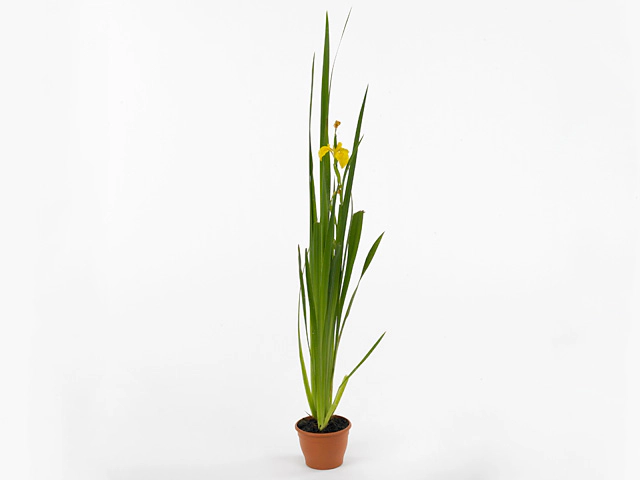Iris pseudacorus

| Leaf tip | Pointed/acute |
| Leaf margin | Entire |
| Flower scent | Unscented |
| Winter hardness | Excellent (USDA-zone 1,2,3,4) |
| Flower color | Yellow; Yellow-medium yellow-007A |
| Flower diameter | 6,5 - 7 cm |
| Plant height | 60 - 70 cm; 70 - 80 cm |
| Inflorescence | Single-flowered |
| Flowering month(s) | May; June; July |
| Leaf width | 1 - 2 cm |
| Leaf size | 50 - 75 cm |
| Leaf, main color | Dark green |
| Leaf colour, pattern | Unicolored |
| Flower color distribution | Unicolored |
| Toxicity (if consumed) | Fairly |
The Iris pseudacorus, commonly known as the Iris, is a beautiful flowering plant that belongs to the family Iridaceae. With its vibrant yellow flowers and dark green leaves, this plant is a popular choice among gardeners and landscape designers.
One of the distinguishing features of the Iris is its pointed or acute leaf tips. The entire leaf margin adds to its elegant and graceful appearance. The plant reaches a height of about 60 to 80 cm, making it suitable for border plantings or as a standout feature in gardens.
The Iris pseudacorus is known for its excellent winter hardiness, making it suitable for USDA zones 1 to 4. This means that it can withstand even the harshest winter conditions, making it a reliable and resilient plant for colder climates.
The flowers of the Iris are unscented but make up for it with their stunning color. The petals are a beautiful yellow, ranging from medium to a slightly darker shade. The flower diameter is around 6.5 to 7 cm, creating a dramatic and eye-catching display when in full bloom. The flowers appear in the months of May, June, and July, adding a burst of color and beauty to the garden during the summer season.
In terms of foliage, the Iris has long and slender leaves, with a width of about 1 to 2 cm. The leaf size ranges from 50 to 75 cm, providing a striking contrast to the vibrant flowers. The main color of the leaves is a dark green, adding depth and richness to the overall aesthetic.
The Iris pseudacorus is a single-flowered plant, with each flower emerging individually on the stem. This creates a simple and elegant inflorescence, allowing each flower to stand out on its own. The flower color distribution is unicolored, providing a uniform and cohesive appearance to the plants.
While the Iris is a stunning addition to any garden, it is important to note that it has a fairly low toxicity level if consumed. Therefore, it is essential to keep it out of reach of children and pets.
For optimal growth, the Iris requires full sun exposure. It thrives in moist soil conditions, making it ideal for wetland restoration projects or gardens with adequate water supply. Its tolerance to wet soil makes it a suitable option for areas prone to flooding or excessive moisture.
The Iris pseudacorus serves multiple purposes in landscaping and gardening. Its vibrant flowers and attractive foliage make it a popular choice for ornamental purposes. Its ability to tolerate wet conditions also makes it a valuable plant for wetland restoration projects.
In conclusion, the Iris pseudacorus is a versatile and visually appealing plant that can enhance the beauty of any garden or landscape. With its yellow flowers, dark green leaves, and excellent winter hardiness, this plant is a reliable and stunning addition to any outdoor space. Whether used for ornamental purposes or wetland restoration, the Iris is sure to captivate and impress with its vibrant colors and graceful appearance.
Market availability index by month:
| Jan. | Feb. | Mar. | Apr. | May | Jun. | Jul. | Aug. | Sep. | Oct. | Nov. | Dec. |
|---|---|---|---|---|---|---|---|---|---|---|---|
| - | 3 | 4 | 3 | 3 | 2 | - | - | 1 | - | - | - |